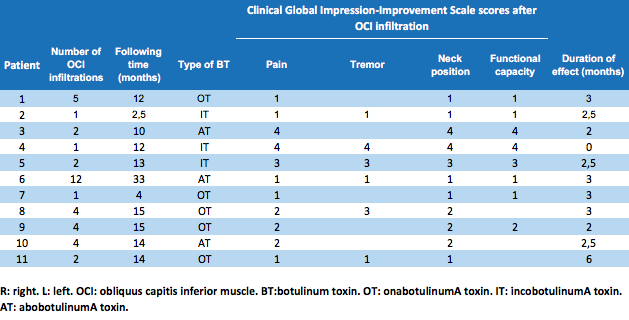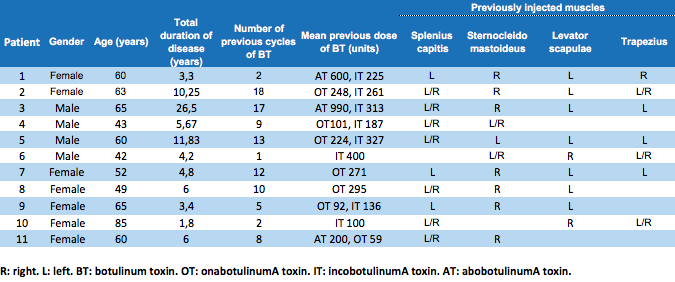Category: Dystonia: Clinical Trials and Therapy
Objective: To communicate the results of infiltration of obliquus capitis inferior (OCI) muscle in complex cervical dystonia (CD).
Background: Treatment of CD with botulinum toxin (BT) is sometimes a challenge, and in some refractory patients it is important a good assessment of the clinical pattern. This is the case in mixed CD patterns of the coll-caput types, particularly when OCI muscle is involved. The OCI muscle contributes to head rotation and is active in most patients with torticaput/torticollis, and mixed patterns. Its infiltration is potentially useful in these cases. A specific training for ultrasound-guided injections is required [1, 2].
Method: Retrospective analysis of electronic records of patients with CD of our movement disorders unit who underwent ultrasound-guided OCI infiltration.
Results: Eleven patients (4 males) with an average duration of disease (DOD) of 7,6 ± 6,9 years were included. All had torticollis and 7 had tremor. Most had undergone a variable number of cycles (8,8 ± 5,9) of BT infiltration with poor response regarding clinical variables (pain, tremor, position and functional capacity) assessed with the Clinical Global Impression-Improvement Scale (mean scores 3,0 ± 0,8; 3,1 ± 0,7; 3,0 ± 0,8 and 2,9 ± 0,6 respectively) [table 1]. After 2,6 ± 1,5 OCI infiltration cycles (5 patients with 57 ± 16 U of onabotulinumA toxin, 3 with 71 ± 19 U of incobotulinumA toxin and 3 with 131 ± 23 U of abobotulinumA toxin) and a follow-up of 13,1 ± 7,8 months, 8 notably improved, while 3 did not (all males, with significantly longer DOD – p = 0,02). A non-significant trend to improvement was observed (2,0 ± 1,2; 2,2 ± 1,3; 2,0 ± 1,2; 2,1 ± 1,4 respectively), although women showed significative improvement in pain and position (p < 0,05). There were no differences in average duration of BT effect (2,5-3 months) and no adverse events were observed [table 2].
Conclusion: The infiltration of OCI is safe and feasible with specific training and expertise, and it may offer a clinical benefit to patients refractory to conventional patterns of infiltration, particularly those manifesting torticollis, as our series illustrates.
References: 1. Schramm A, Huber D, Möbius C, Münchau A, Kohl Z, Bäumer T. Involvement of obliquus capitis inferior muscle in dystonic head tremor. Parkinsonism Relat Disord. 2017 Nov;44:119-123. 2. Jost WH. Torticaput versus Torticollis: Clinical Effects with Modified Classification and Muscle Selection. Tremor Other Hyperkinet Mov (N Y). 2019 Jul 12;9.
To cite this abstract in AMA style:
A. Beltrán, F. Rodríguez, J.L Chico García, P. Parra, I. Pareés, J.C Martínez Castrillo, A. Alonso Cánovas, G. Sánchez. Refractory cervical dystonia: is the infiltration of the obliquus capitis inferior muscle a game changer? [abstract]. Mov Disord. 2020; 35 (suppl 1). https://www.mdsabstracts.org/abstract/refractory-cervical-dystonia-is-the-infiltration-of-the-obliquus-capitis-inferior-muscle-a-game-changer/. Accessed December 31, 2025.« Back to MDS Virtual Congress 2020
MDS Abstracts - https://www.mdsabstracts.org/abstract/refractory-cervical-dystonia-is-the-infiltration-of-the-obliquus-capitis-inferior-muscle-a-game-changer/


